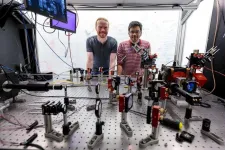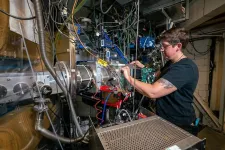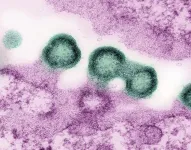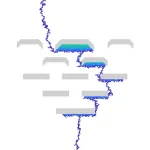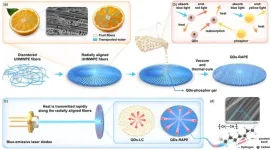(Press-News.org) Quantum information systems offer faster, more powerful computing methods than standard computers to help solve many of the world’s toughest problems. Yet fulfilling this ultimate promise will require bigger and more interconnected quantum computers than scientists have yet built. Scaling quantum systems up to larger sizes, and connecting multiple systems, has proved challenging.
Now, researchers at the University of Chicago’s Pritzker School of Molecular Engineering (PME) have discovered how to combine two powerful technologies—trapped atom arrays and photonic devices—to yield advanced systems for quantum computing, simulation and networking. The new combination will allow the construction of large quantum systems which can be easily scaled up, by leveraging photonics to interconnect individual atom arrays.
“We have merged two technologies which, in the past, have really not had much to do with each other,” said Hannes Bernien, Assistant Professor of Molecular Engineering and senior author of the new work, published in Nature Communications. “It is not only fundamentally interesting to see how we can scale quantum systems in this way, but it also has a lot of practical applications.”
Arrays of neutral atoms trapped in optical tweezers—highly focused laser beams that can hold the atoms in place—are an increasingly popular way of building quantum processors. These grids of neutral atoms, when excited in a specific sequence, enable complex quantum computation that can be scaled up to thousands of qubits. However, their quantum states are fragile and can be easily disrupted—including by photonic devices that aim to collect their data in the form of photons.
“Connecting atom arrays to photonic devices had been quite challenging because of the fundamental differences in the technologies. Atom array technology relies on lasers for their generation and computation.” said Shankar Menon, a PME graduate student and co-first author of the new work. “As soon as you expose the system to a semiconductor or a photonic chip, the lasers get scattered, causing problems with the trapping of atoms, their detection and the computation.”
In the new work, Bernien’s group developed a new semi-open chip geometry allowing atom arrays to interface with photonic chips, overcoming these challenges. With the new platform, quantum computations can be carried out in a computation region, and then a small portion of those atoms containing desired data are moved to a new interconnect region for the photonic chip integration.
“We have two separate regions that the atoms can move between, one away from the photonic chip for computation and another near the photonic chip for interconnecting multiple atom arrays,” explained co-first author Noah Glachman, a PME graduate student. “The way this chip is designed, it has minimal interaction with the computational region of the atom array.”
In the interconnect region, the qubit interacts with a microscopic photonic device, which can extract a photon. Then, the photon can be transmitted to other systems through optical fibers. Ultimately, that means that many atom arrays could be interconnected to form a larger quantum computing platform than is possible with a single array.
An additional strength of the new system—which could lead to especially speedy computation abilities—is that many nanophotonic cavities can be simultaneously connected to one single atom array.
“We can have hundreds of these cavities at once, and they can all be transmitting quantum information at the same time,” said Menon. “This leads to a massive increase in the speed with which information can be shared between interconnected modules.”
While the team showed the feasibility of trapping an atom and moving it between regions, they are planning future studies that look at other steps in the process, including collection of the photons from the nanophotonic cavities, and the generation of entanglement over long distances.
END
Combining trapped atoms and photonics for new quantum devices
A new platform lets PME researchers combine atom array processors with photonic and semiconductor chips
2024-07-23
ELSE PRESS RELEASES FROM THIS DATE:
A new way to make element 116 opens the door to heavier atoms
2024-07-23
Scientists at the Department of Energy’s Lawrence Berkeley National Laboratory (Berkeley Lab) are credited in the discovery of 16 of the 118 known elements. Now they’ve completed the crucial first step to potentially create yet another: element 120.
Today, an international team of researchers led by Berkeley Lab’s Heavy Element Group announced that they have made known superheavy element 116 using a titanium beam, a breakthrough that is a key stepping stone towards making element 120. The result was presented today at the Nuclear Structure 2024 conference; the science paper will be posted on the online repository ...
New genetic tool could identify drug targets for diseases associated with metabolic dysfunction
2024-07-23
There’s a glaring gap in our knowledge of cell metabolism: in many cases, we still don’t know exactly how nutrients are transported into the cell. Without that understanding, it’s extremely difficult, if not impossible, to develop treatments for the many diseases linked to the protein transporters that drive metabolism. Now, a new study in Nature Genetics presents a tool to map these metabolic gene functions more precisely. The platform, dubbed GeneMAP, has already identified one key gene-metabolite association at the heart of mitochondrial metabolism.
GeneMAP was developed in the laboratory of Kivanç Birsoy, ...
Plant Biologist Siobhan Brady named HHMI Investigator
2024-07-23
iobhan Brady, a professor in the Department of Plant Biology and Genome Center at the University of California, Davis, has been selected as a Howard Hughes Medical Institute (HHMI) Investigator. The prestigious Investigator program, which Brady describes as “life changing,” will provide her with roughly $9 million in research support over a seven-year term, with the option to renew.
Brady’s research aims to understand how plants use their roots to respond to environmental stressors, and to use this information to develop plants that are better able to respond to climate ...
Long-acting injectable cabotegravir for HIV prevention is safe in pregnancy
2024-07-23
Long-acting injectable cabotegravir (CAB-LA) was safe and well tolerated as HIV pre-exposure prophylaxis (PrEP) before and during pregnancy in the follow-up phase of a global study among cisgender women. The analysis of outcomes from more than 300 pregnancies and infants will be presented at the 2024 International AIDS Conference (AIDS 2024) in Munich, Germany.
“Cisgender women experience biological changes and social dynamics that can increase their likelihood of acquiring HIV during pregnancy and the postnatal period, and we need to offer them evidence-based options when they may need them most,” said Jeanne Marrazzo, M.D., M.P.H., ...
Large language models don’t behave like people, even though we may expect them to
2024-07-23
CAMBRIDGE, MA – One thing that makes large language models (LLMs) so powerful is the diversity of tasks to which they can be applied. The same machine-learning model that can help a graduate student draft an email could also aid a clinician in diagnosing cancer.
However, the wide applicability of these models also makes them challenging to evaluate in a systematic way. It would be impossible to create a benchmark dataset to test a model on every type of question it can be asked.
In a new paper, MIT researchers took a different approach. They ...
NREL researchers highlight opportunities for manufacturing perovskite solar panels with a long-term vision
2024-07-23
Researchers working at the forefront of an emerging photovoltaic (PV) technology are thinking ahead about how to scale, deploy, and design future solar panels to be easily recyclable.
Solar panels made of perovskites may eventually play an important role amid global decarbonization efforts to reduce greenhouse gas emissions. As the technology emerges from the testing stages, it is a perfect time to think critically about how best to design the solar panels to minimize their impact on the environment decades from now.
“When you have a technology in its very early stages, you have the ability to design it better. It’s a cleaner slate,” said Joey Luther, a senior ...
Top Medicare advantage plans less available in disadvantaged areas
2024-07-23
Looking for a Medicare Advantage plan with a five-star quality rating? You’re less likely to find one available to you if you live in a county with higher poverty and unemployment, finds a new study published in JAMA Network Open.
These geographic disparities may be contributing to unequal health outcomes and limiting federal funds from reaching the regions most in need, according to the researchers.
“What this means is that Medicare beneficiaries living in counties with greater social disadvantage ...
Better carbon storage better carbon storage with stacked geology with stacked geology
2024-07-23
The overarching goal of all carbon capture and storage projects is the same: Keep carbon dioxide (CO2) emissions out of the atmosphere by storing them in the subsurface for good.
One way to do that is to inject the CO2 into a reservoir space that’s covered with a big lid – an impermeable caprock that can keep the gas in place and stop any upward flow in its tracks. That’s the model that petroleum exploration has relied on for decades when searching for oil traps, and it works for both oil and CO2. But according to research led by The University of Texas at Austin’s Bureau of Economic Geology, subsurface ...
Sharp temperature reduction for quantum dots in polymer by highly efficient heat dissipation pathways
2024-07-23
A new publication from Opto-Electronic Advances; DOI 10.29026/oea.2024.240036 , discusses sharp temperature reduction for quantum dots in polymer by highly efficient heat dissipation pathways.
Quantum dots (QDs), a kind of luminescent nanocrystals featuring size-tunable emission spectra and superior color purity are widely applied in optoelectronic fields. However, these particles are facing luminous efficiency degradation due to their temperature-sensitive characteristic and the high temperature in optoelectronic ...
UAF researcher creates way to detect elusive volcanic vibrations
2024-07-23
A new automated system of monitoring and classifying persistent vibrations at active volcanoes can eliminate the hours of manual effort needed to document them.
Graduate student researcher Darren Tan at the University of Alaska Fairbanks Geophysical Institute led development of the system, which is based on machine learning. Machine learning is a branch of artificial intelligence focused on building systems that learn from data, identify patterns and make decisions with minimal human intervention.
Details about Tan’s automated ...
LAST 30 PRESS RELEASES:
Sleeping in on weekends may help boost teens’ mental health
Study: Teens use cellphones for an hour a day at school
After more than two years of war, Palestinian children are hungry, denied education and “like the living dead”
The untold story of life with Prader-Willi syndrome - according to the siblings who live it
How the parasite that ‘gave up sex’ found more hosts – and why its victory won’t last
When is it time to jump? The boiling frog problem of AI use in physics education
Twitter data reveals partisan divide in understanding why pollen season's getting worse
AI is quick but risky for updating old software
Revolutionizing biosecurity: new multi-omics framework to transform invasive species management
From ancient herb to modern medicine: new review unveils the multi-targeted healing potential of Borago officinalis
Building a global scientific community: Biological Diversity Journal announces dual recruitment of Editorial Board and Youth Editorial Board members
Microbes that break down antibiotics help protect ecosystems under drug pollution
Smart biochar that remembers pollutants offers a new way to clean water and recycle biomass
Rice genes matter more than domestication in shaping plant microbiomes
Ticking time bomb: Some farmers report as many as 70 tick encounters over a 6-month period
Turning garden and crop waste into plastics
Scientists discover ‘platypus galaxies’ in the early universe
Seeing thyroid cancer in a new light: when AI meets label-free imaging in the operating room
Neutrophil-to-lymphocyte ratio may aid risk stratification in depressive disorder
2026 Seismological Society of America Annual Meeting
AI-powered ECG analysis offers promising path for early detection of chronic obstructive pulmonary disease, says Mount Sinai researchers
GIMM uncovers flaws in lab-grown heart cells and paves the way for improved treatments
Cracking the evolutionary code of sleep
Medications could help the aging brain cope with surgery, memory impairment
Back pain linked to worse sleep years later in men over 65, according to study
CDC urges ‘shared decision-making’ on some childhood vaccines; many unclear about what that means
New research finds that an ‘equal treatment’ approach to economic opportunity advertising can backfire
Researchers create shape-shifting, self-navigating microparticles
Science army mobilizes to map US soil microbiome
Researchers develop new tools to turn grain crops into biosensors
[Press-News.org] Combining trapped atoms and photonics for new quantum devicesA new platform lets PME researchers combine atom array processors with photonic and semiconductor chips
